Book contents
- Frontmatter
- Contents
- Series Foreword
- Preface
- 1 Teams and the Transformation of Work
- 2 Disturbance Management and Masking in a Television Production Team
- 3 Teamwork between Adversaries: Coordination, Cooperation, and Communication in a Court Trial
- 4 Displacement and Innovation in Primary Care Medical Teams
- 5 Crossing Boundaries in Teacher Teams
- 6 Knowledge Creation in Industrial Work Teams
- 7 Teams, Infrastructures, and Social Capital
- 8 From Iron Cages to Webs on the Wind
- 9 Knotworking and Agency in Fluid Organizational Fields
- References
- Author Index
- Subject Index
- Titles in the series
4 - Displacement and Innovation in Primary Care Medical Teams
Published online by Cambridge University Press: 05 June 2012
- Frontmatter
- Contents
- Series Foreword
- Preface
- 1 Teams and the Transformation of Work
- 2 Disturbance Management and Masking in a Television Production Team
- 3 Teamwork between Adversaries: Coordination, Cooperation, and Communication in a Court Trial
- 4 Displacement and Innovation in Primary Care Medical Teams
- 5 Crossing Boundaries in Teacher Teams
- 6 Knowledge Creation in Industrial Work Teams
- 7 Teams, Infrastructures, and Social Capital
- 8 From Iron Cages to Webs on the Wind
- 9 Knotworking and Agency in Fluid Organizational Fields
- References
- Author Index
- Subject Index
- Titles in the series
Summary
The television production team and the court trial team, analyzed in Chapters 2 and 3, respectively, are examples of teams that were not specifically designed as teams, based on some explicit theory or form of team organization. In the court case, the judge attempted to design the teamwork, but this attempt was not based on an articulated theory or framework. In both the television team and the court team, this absence of deliberate design also meant that the teams had created few if any tools to enhance collaboration and reflection. This instrumental poverty seemed to account for many of the difficulties in the work of those teams.
In this chapter, I analyze health care teams that were deliberately designed as new forms of organizing work. Will such teams develop and use specific tools to facilitate their collaboration and collective reflection? How do such tools interact with the objects of work that the teams try to formulate and accomplish? And what is the role of scripts in the work of such teams? In sum, how does a new team construct its own practices, its modus operandi?
Complex clinical procedures such as demanding surgeries have always required collaborative teamwork. However, in such operative medical teams there is usually a very clear vertical command structure and a predetermined division of labor that make the team more like a commando task force dedicated to a single purpose than a general-purpose method of organizing cooperative work and enhancing horizontal exchange of information across potential boundaries.
- Type
- Chapter
- Information
- From Teams to KnotsActivity-Theoretical Studies of Collaboration and Learning at Work, pp. 64 - 85Publisher: Cambridge University PressPrint publication year: 2008
- 1
- Cited by



